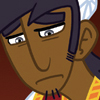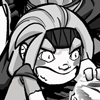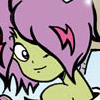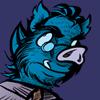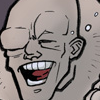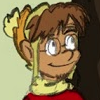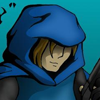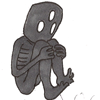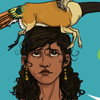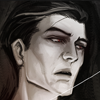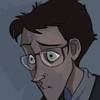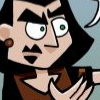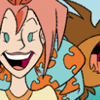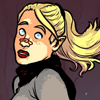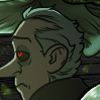Monthly Archives: September 2010
Metapost: Short break
Well, it’s around that time again: time to take a break. First week of October is a pretty busy one for me in Real Life, so I’m going to take about two weeks off from blogging about webcomics.
In the meantime, post in the comments section a webcomic you think isn’t getting enough attention! I’ll put together a list of the suggestions, Warren Ellis style, when I get back.
I have seen the future and it won’t stop moving

So what’s the future of webcomics? Heidi MacDonald and Scott McCloud think that webcomics may need a little action in the back section, if ya know what I mean.
In other words: motion comics.
Scott McCloud, noted advocate for webcomics providing things that are impossible in print, commented at his blog:
Got two emails in the last few days with links to two new webcomics using navigation techniques that neatly sum up this interesting technological moment we’re in.
Turbo Defiant Kimecan by Mexican artist Ferran Daniel uses Flash to load one panel or element at a time. We’ve seen a few comics like it, but this one gets points for some pretty artwork. Curious to hear what people think of this sort of loading order, now that we’ve seen it a few times. (Maybe time to revisit this discussion?)
Meanwhile, along comes an HTML 5 comic, Never Mind the Bullets (cooked up by Steaw Web Design to show off Microsoft’s IE9). More proof-of-concept than anything else, but it’s kind of cool and got me thinking about how that layered effect could be used in other ways. (thanks again to Randy Oest for the tip).
Of course, the real shoot-out going on this year is between file formats, and with the recent back-and-forth in the mobile space over Flash and HTML 5, it’s helpful to have some concrete reminders of the very different creative directions each might take us in.
From Heidi MacDonald at The Beat:
McCloud has been pointing to these kinds of formal explorations for a while; neither of the above succeeds as comics or interaction BUT they do present intriguing possibilities. Every technology gets its D.W. Griffith, and it’s just a matter of time before some kid latches onto what’s intuitive and informative about these possibilities.
In the comments, Swiss artist Michael Kühni links to his own experiments with Flash, which are far more successful.
There’s also Boi by Vincent Giard, which uses Flash to convey that hungover feeling–to good effect.
There’s also Dan Goldman’s recently concluded Red Light Properties, another Flash-based story which had several technical upgrades along the way.
Overall, we see an unevenly evolving picture, as individuals mess around and come up with novelty ideas, some charming, some…awkward. The two examples McCloud points to do suggest possibilities however — Never Mind The Bullets, while poorly drawn, suggests the ability to follow stories in a more spatial way (clicking to go into an environment) without going full-on animation.
Both acknowledge that the example have met with quite a bit of criticism. (McCloud: “I’m not endorsing either approach as “the future of comics” or anything. But it’s always interesting to see how many different reading models there are, and even failed attempts can sometimes contain useful ideas.”) This is only right, since Flash, especially the glacially loading variety from our pals at Zuda, is a bad word around these parts. But is this, perhaps, what we are to expect our webcomics to be in the decade to come? After all, just a decade ago, it was enough to have a screen filled with dancing bananas and MIDI files. Is it possible that these two examples represent the next level of sophistication?
(h/t Spy6teen, whose trackback led me to the articles, and commenter Pierre Lebeaupin, whose comment on Never Mind the Bullets led me to that particular comic in the first place)
How much money can you make doing webcomics?
If you’re Dorothy Gambrell of Cat & Girl (compete.com places the readership at a respectable 50K, which was up considerably from previous months), roughly $10,000 for six months ($20,000 for the year according to Sean Kleefeld.) That’s income only, and doesn’t count expenses.
From Brigid Alverson:
In one way, Gambrell is living the stereotype: Her biggest source of income in most months is T-shirt sales, although she sold a lot of books in August. Freelance work also gives her a boost. The bottom line: So far this year, she has taken in $10,087.56 from her comic, a respectable second income but not enough to live on. And that isn’t her net—she has yet to deduct taxes, PayPal fees, and other expenses.
Not enough to quit the day job. Here’s Wikipedia’s list, by the way, of “self-sufficient webcomics“, i.e. ones that the creator can live off of.
Zuda is officially pronounced dead

The sad news comes from Robot 6. DC Comics is doing some housecleaning… with an axe. Among the divisions getting the axe: the Wildstorm imprint, which was the home of comics like WildCATs, The Authority, StormWatch, and Gen13 (which comic diehards probably remember mostly under the Image banner); and, of course, former webcomic imprint, Zuda Comics, home to Harvey-winning comic High Moon, Eisner-nominated Bayou, Azure, Night Owls, Lily of the Valley, Black Cherry Bombshells, and LaMorte Sisters. No word yet on whether these titles will simply cease to exist or whether they will be folded into DC’s existing brands (like Vertigo).
—————————————-
UPDATE: Actually, it seams like The Beat is on top of this (as they always are; yeah, yeah, it was also mentioned in the Robot 6 piece but I totally missed the second link thanks to a lack of quotable quotes). From a note by co-publishers Jim Lee and Dan DiDio:
After this week, we will cease to publish new material under the ZUDA banner. The material that was to have been published as part of ZUDA this year will now be published under the DC banner. The official closing of ZUDA ends one chapter of DC’s digital history, but we will continue to find new ways to innovate with digital, incorporating much of the experience and knowledge that ZUDA brought into DC.
Whether the formerly Zuda titles can compete with the existing titles or not remains to be seen.
————————————-
What’s killing these brands? Superheroes.
“These organizational changes reinforce the strengths of DC’s greatest legacies – most importantly its people and its creative talent – and offer greater opportunity for maximum growth, success and efficiency in the future,” said Nelson. “Our two offices will stretch and build their respective areas of focus, while prioritizing and aggressively striving to connect and cooperate more strongly than ever before between them and with their colleagues at Warner Bros.”
“This strategic business realignment allows us to fully integrate and expand the DC brand in feature films as well as across multiple distribution platforms of Warner Bros. and Time Warner,” said Jeff Robinov, President, Warner Bros. Pictures Group, to whom Nelson reports. “We are creating a seamless, cohesive unit that will bring even more great characters and content to consumers everywhere.”
In other words: “We totally missed the superhero movie gravy boat that Disney/Marvel have been riding on, and we need to get rid of all the distractions.”
Zuda already was functionally in the ground when it shut down online. Now it’s time to put the dirt on the coffin.
The red challenge flag: when is a webcomic not a webcomic?

So what are webcomics? Well, the pat response (and one of my favorite lines from an old webcomic that has since disappeared from the net) is typically that “webcomics are comics … on the web!”
Except when they’re not.
Like the battle between Americans, Canadians, and the rest of the world over what or what not should be called “football,” the term “webcomics” has outgrown the original simple definition implied by the nature of it’s compound noun. So what’s a webcomic? It’s not as simple as it sounds. Webcomic readers have accepted that captioned photos and Venn Diagrams written on index cards can now be counted as webcomics. I Can Has Cheeseburger, on the other hand, is not. Where is the justice in the world?
Here are a few comic examples that often get thrown the red challenge flag for penalties against being a webcomic.
Read the rest of this entry
The Webcomic Overlook #135: Virtual Shackles

It’s the dream of every little gamer to want to grow up to be a video game programmer. That’s because they don’t know about the 20 hour work days and the suffocating deadlines and the bucketloads of shovelware that needs coding that makes you eventually want to give it all up and take a job selling mattresses. No, when you don’t know any better, programming is all about seeing your imagination come to life on a video game screen and, to a far lesser extent, dreaming of the a chance to date Playboy model Stevie Case.
Jeremy Vinar and Mike Fahmie are two such programmers. Both have worked around the gaming industry, toiling on illustrious content like High School Musical 3: Senior Year DANCE! (XBox 360, PS2, Wii, and PC), Tomb Raider: Underworld (Nintendo DS), and Superman Returns (Nintendo DS, Nintendo GBA).
While their computing efforts may not exactly make them candidates for the next PC Gamer “New Game Gods” feature, these two do stand a chance at making their mark on webcomics with Virtual Shackles, with Vinar doing the art and Fahmie doing the humor. Some of the strips look like they’re based on their their experiences, since the two protagonists, Orion and Jack, also work as video game company employees. Of course, as with all video game comics that part’s just window dressing for the multitude of parodies and caricatures of popular characters, the life blood of the video game webomic industry.
New Brighton Archeological Society goes online
Brigid Alverson of Robot 6 notes that Mark Andrew Smith, the two-time Harvey Award nominee for the all-ages The New Brighton Archeological Society (Image Comics), has posted the first volume online. From Wikipedia:
The story of the New Brighton Archeological Society follows the children from two families of the world’s most famous explorers. When their parents are lost on an Archeological mission to thwart their nemesis named Galomar, the children find themselves under the care of their Godparents and living in their parents’ old childhood home. During a snowball fight the children accidentally find their parents old clubhouse called “The New Brighton Archeological Society”. The children start the club up again to honor their parents’ memory but also find many strange books filled with information about supernatural worlds and lore.
When asked about why he put the comic online, Mark Andrew Smith had a few good things to say about webcomic creators and readers:
Robot 6: You just got nominated for a Major Comics Award. Why are you putting your comic online for free?
MAS: The New Brighton Archeological Society was nominated for two Harvey Awards this year. I think online is a great opportunity to develop a new readership over the course of a year while we work on the second volume in the series. I’ve been reading a lot of online comics and I’ve been very impressed with how they’re doing and the audiences and subscribers that they’re able to reach and retain daily. In comics we don’t have that direct line of communication with our audience and it’s something that I wanted to build. It’s also great for sales for when the second volume comes out to have that built in audience and the communication with them. In the future I think this will be more of a standard model by which comics are created.
Robot 6: Connecting kids with kid-friendly webcomics is always a challenge. How do you plan to build an audience?
MAS: We’ve gotten very great press and I’ve been promoting the book heavily. I want to do a blog tour on YA Lit blogs and I have another secret project that’s going to start online, so with that I’ll push the two hand in hand. There are a lot of ways to build an audience and it’s about getting creative and thinking outside of the box. I have some very big things planned. A lot of people think the market is tapped and are doom and gloom, but webcomics are at the frontlines, and we just have to get creative. We’re living in the most exciting time for comics and soon the dam is going to burst and they will be a mainstream part of daily American culture. I strongly believe this to be true.







